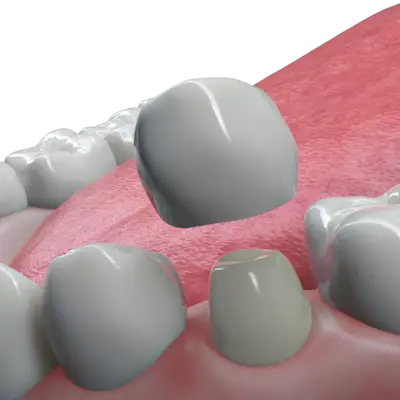
A tooth may need a dental crown for a wide variety of reasons. Because a dental crown replaces the enamel covering of a tooth, a general answer to this question is that a tooth needs a dental crown when the enamel no longer performs its function. Enamel is the hardest substance in the human body, designed to withstand the thermal, chemical and mechanical forces our teeth undergo when we eat and drink. Unfortunately, however, it is not invincible.
A “dental crown” is a term familiar to most people, though some refer to it as a “cap.” There are actually two uses of the term crown in dentistry. We use the word crown to describe the anatomical portion of each tooth that protrudes out of the gums and bone. The crown of the tooth does not include the tooth’s roots, and in a healthy tooth, enamel covers the entire crown.
A crown may also refer to a specific type of dental restoration that covers the entire anatomical crown of a tooth. This is the type of crown we will cover in the remainder of this article. A dental crown typically covers the exposed portion of a tooth (we call this full coverage) and replaces all of its enamel. This means that the edges of a dental crown, called the margin, rest very close to the gum tissues surrounding the tooth. The exact placement of the margin depends on multiple factors that your dentist considers when planning the crown.
A tooth may need a dental crown for a wide variety of reasons. Because a dental crown replaces the enamel covering of a tooth, a general answer to this question is that a tooth needs a dental crown when the enamel no longer performs its function. Enamel is the hardest substance in the human body, designed to withstand the thermal, chemical and mechanical forces our teeth undergo when we eat and drink. Unfortunately, however, it is not invincible.
Enamel is susceptible to cracking, acid erosion, and decay (cavities). All of these can lead to the need for a crown. The following are the most common reasons that a tooth may need coverage with a dental crown.
1. Large Cavities – Cavities are bacterial infections of the enamel and other hard substances that make up each tooth. Bacteria eat sugar and produce acid, which can dissolve enamel and allow the bacteria to penetrate a tooth. As a cavity grows, it weakens and undermines the enamel so that it can no longer support healthy chewing function. Your dentist evaluates the size of a cavity and the amount of remaining healthy tooth structure to determine whether the tooth requires a filling or a dental crown. In many cases, the cavity is so large that what is left of the tooth cannot support a filling.
2. Large Fillings – The presence of an existing large filling may necessitate a dental crown on a tooth. While a filling is a wonderful restoration to replace tooth structure lost from decay, it does not add strength to a tooth. It simply fills in the hole. When a filling is large and makes up more than half of the exposed tooth, a crown may be necessary to prevent further damage.
3. Severe Acid Erosion – Patients who suffer from severe acid reflux or GERD, or those with acidic habits (like drinking sodas daily), often lose significant amounts of enamel through erosion. Rebuilding these teeth and replacing the lost enamel is necessary to prevent more damage and even eventual loss of the tooth itself.
4. Loss of Enamel from Heavy Clenching/Grinding – Another area of significant enamel loss is the mechanical wear and tear that occurs from heavy clenching and/or grinding during sleep. This leads to shortening and flattening of the teeth as enamel slowly wears away. As with acid erosion, rebuilding these teeth helps prevent further damage and eventual tooth loss.
5. Cracked Teeth – While cracks are more likely to develop on teeth that have large fillings, they can occur in otherwise healthy teeth as well. Cracks are common in the back molars of people who clench or grind their teeth at night. They may also result from an injury, such as biting into a hard, foreign object. When a tooth cracks, the interruption in enamel allows both temperature sensations and bacteria to penetrate the tooth. A crack often leads to cavities and sensitivity to cold and/or chewing forces.
6. Root Canal Treatment – Lastly, a tooth that undergoes a root canal treatment usually needs full coverage with a dental crown. This is because root canal treatments remove the nerves and blood supply from the hollow chamber inside a tooth. Without a blood supply, teeth become brittle and very easy to break. Because they also have no nerve within, teeth with root canal treatments will not experience the symptoms of a cracked tooth, so patients often miss the warning signs of a problem. A crown covering the tooth is necessary to prevent its breakage after a root canal treatment.
In order to make a crown that fits perfectly, your dentist first prepares the tooth itself. Preparation involves removal of the enamel layer so that the crown can replace it without making the restoration bulky or uncomfortable. We also remove any existing decay or filling material. Basically, we get down to healthy tooth structure and rebuild from there.
Enamel is the protective coating of a tooth, and without it, the tooth is sensitive to hot and cold. This is why a dental crown preparation typically requires local anesthetic (but it is not necessary when the tooth has a root canal treatment, because there is no longer a nerve inside to feel that discomfort). This is also why we must cover the tooth with a temporary crown for the time necessary to make the final crown. A temporary crown insulates the tooth from uncomfortable sensations and holds the space for the final crown.
Step-by-Step Process for a Dental Crown
Visit 1:

Visit 2 (Typically 2 weeks later):

In general, no.
There may be some parts of the visit that you find uncomfortable, but you should not experience pain when you receive a dental crown. We always work to ensure our patients’ are at ease with any procedure using local anesthetic. Once your tooth is numb, you should not feel anything during the crown preparation process.
You should expect the tooth to be a little sore and/or sensitive for the first few days following a dental crown preparation, similar to symptoms following a dental filling. Any symptoms should dissipate over a 2-3 week period, so that the tooth feels “normal” when you return for the final crown. Your temporary crown should feel comfortable when you bite and smooth to your tongue.
Dental crowns are rarely optional, so a discussion of the advantages and disadvantages may be a bit irrelevant. If you need a crown, a different dental restoration (like a filling) will not truly restore the tooth and will only provide a temporary “fix”. Even so, it does help to understand the advantages and disadvantages of a dental crown so that you can make the best investment and provide the best long-term care for your teeth.
Advantages:
Disadvantages:

Gold
Rarely used by dentists today, a mixture of high-noble metals make full gold dental crowns. Gold has the advantage of being very gentle to the opposite tooth that bites against it. It can also be quite thin, thus preserving healthy tooth structure. Metallic crowns also have some antibacterial properties, making them slightly more resistant to new cavities at the margins.
Traditional Porcelain-Fused-to-Metal
Over the past few decades, the type of crown with the most popularity is the porcelain-fused-to-metal material. This crown has a core of silver-colored metal covered by tooth-colored porcelain. It has an obvious cosmetic advantage over gold crowns. The metal core gives an opaque appearance to the crown. It does require a minimum thickness, so your dentist must remove more tooth structure for a PFM than for gold. These crowns are strong and durable for decades, though they will break under heavy or destructive forces.
All Porcelain
All porcelain crowns are the most natural and beautiful crowns your dental lab can make. They allow some light to show through (translucence), just as real enamel does. Containing no metal, so there is no darkness or metal show through in the appearance of the crown. All porcelain crowns are less conservative, requiring a good amount of tooth removal, and have a higher risk of breaking than PFMs.
Zirconia
Zirconia is a relatively new material that is tooth colored ceramic like porcelain, but with strength properties more similar to that of metal crowns. There is no dark metallic color in zirconia, and it is extremely hard, virtually impossible to break. Their cosmetic appearance is almost as nice as all porcelain crowns. Zirconia crowns do however, have the disadvantage of being less translucent than your natural teeth.
A dental crown is a significant investment made for the health of your mouth. The good news is that, with the proper long-term care, crowns can last for many decades!
What is the Typical Lifespan of a Dental Crown?
Most dental crowns “last” (meaning they do not require any further dental work on the tooth) anywhere from five to fifteen years. The lifespan varies narrowly based on the material of the crown and widely based on patient care and maintenance.
Dental insurance companies typically pay out benefits to replace a dental crown only when it was placed a minimum of five years prior.
What Factors Affect the Lifespan of Your Dental Crown?
The most common reason that a crown would not last for decades is the development of a new cavity at the edge, or margin, of the crown. This is typically the result of a false sense of security people have when they receive a dental crown. They mistakenly assume the tooth is no longer at risk for decay. The truth is that the tooth is at a higher risk for cavities, and you must diligently fight them.
In order to promote a long lifespan for your dental crown, you must fight cavities by performing great oral hygiene at home and seeing your dentist consistently for professional teeth cleanings, check-ups, and topical fluoride treatments to help strengthen the teeth. This is true for promoting the lifespan of any dental work.
Another common factor in the lifespan of dental crowns is breakage from heavy forces. If you exhibit signs of clenching and/or grinding your teeth while you sleep, your dentist will prescribe a protective mouthguard to wear at night. Wearing this appliance regularly protects your teeth and any dental work, lengthening the lifespan of crowns and fillings as well as your teeth themselves.
A dental crown can rebuild and preserve your natural tooth, providing you with many more years of healthy chewing function. We take pride in serving each patient with excellence and compassion. Our team is here to help you receive any essential dental care in order to maintain great oral health for decades to come!
Mon – Thu: 8am – 5pm
Fri: 8am – 12pm
Sat: By Appointment Only
Sun: CLOSED
Turtle Creek Dental Associates © 2025 | All Rights Reserved